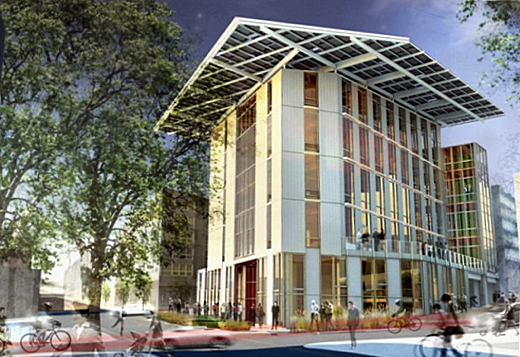 Image above: Architectural rendering of Pike Street side of Bullitt Foundation headquarters being built in Seattle. From original article.
Image above: Architectural rendering of Pike Street side of Bullitt Foundation headquarters being built in Seattle. From original article.
In Seattle, contractors have begun digging for an office building that will eventually wear what looks like a big cocked hat.
It’s a solar-panel array topping off the five-story home for the local Bullitt Foundation.
When it opens next winter, the Bullitt Center will also scrub its own water with the aid of composting toilets.
The new building reflects founder Dorothy Bullitt’s aspiration to turn the Pacific Northwest into a global model of environmental sustainability.
The foundation sources many of its components locally, and strives to eliminate toxins in building materials and ventilating air. Its self-imposed high standards have often been a challenge to the Miller Hull Partnership, the project’s Seattle architect.
These are all requirements of the Living Building Challenge, a program to improve health and minimize building energy use and waste.
Among other things, Miller Hull had to ask manufacturers to reformulate products and dig into the energy performance of desktop computers.
Then they had to figure out how to do all this affordably.
Airy Feel
On its small site, the Bullitt’s roof was the only place to put the solar panels needed to generate the building’s power.
Since Seattle’s ubiquitous clouds admit so little sunlight, Miller Hull partner Ron Rochon, working with PAE Consulting Engineers, had to keep squeezing energy out of the building design to match the panels’ output.
Geothermal wells will supply most of the heat. Offices will feel airy with high ceilings that allow much of the space to forgo electric lights in daytime. Windows will open to cool breezes during Seattle’s mild summers.
The team slashed the usual energy-wasting systems to such a degree that desktop computers dominated the building’s energy demand.
Even so, the building still used too much energy.
The architects and engineers identified slimmed servers and efficient laptops to reduce a standard computer’s consumption of 1,150 watts to just 250, about the same as two household bulbs.
They talked city officials into letting Bullitt expand the solar array by projecting the roof over the sidewalk, normally not permitted. That involved relocating power lines and persuading skeptical neighbors that the roof wasn’t too intrusive.
There were more hoops to jump through. The foundation hoped to harvest drinking water from the roof and avoid chlorinating it.
So far the Environmental Protection Agency has nixed that idea, though the designers are appealing its decision. To treat all the water used onsite, Rochon’s team found marine toilets that will deliver waste to a basement composting room. No one has ever done that, he said.
Well-meaning as they are, I do wonder if many of these measures are worth the effort. Solar -- for now anyway -- is a lost cause in such a dim climate, especially in a city largely driven by clean hydropower.
City Level
Water pollution needs to be tackled at a neighborhood or city scale, not within individual buildings.
Still, there’s a crazy-like-a-fox quality to the Bullitt effort. It has encouraged a German high-performance window-wall manufacturer to build a facility in nearby Everett. A waterproofing-compound manufacturer called Building Envelope Innovations has agreed to reformulate its product without phthalates, a class of chemical compounds that may harm reproductive health.
Seattle has established a 2030 District in and around its downtown to achieve carbon-neutrality by the year 2030.
With Congress hopelessly gridlocked about any energy legislation and Iran blustering as usual, Seattle and Bullitt are pointing the way to a possible future. For $30 million Bullitt won’t just get a handsome, healthy, zero-energy workplace, but one that incubates job growth.
.
No comments :
Post a Comment